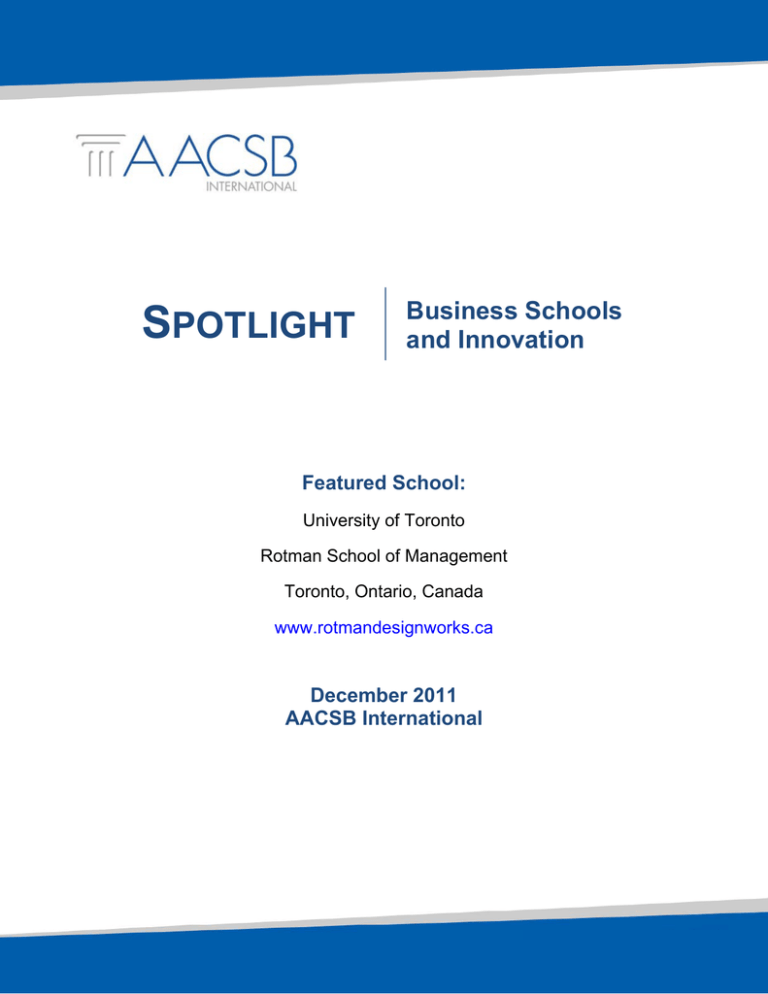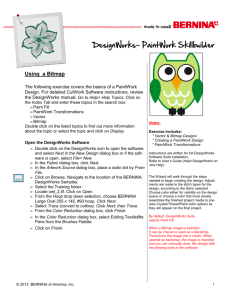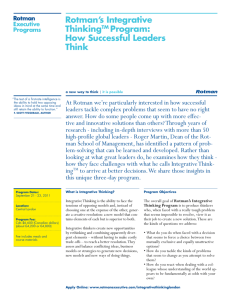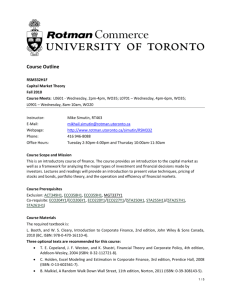
SPOTLIGHT
Business Schools
and Innovation
Featured School:
University of Toronto
Rotman School of Management
Toronto, Ontario, Canada
www.rotmandesignworks.ca
December 2011
AACSB International
SPOTLIGHT | Business Schools & Innovation
Rotman School of Management | 2
The DesignWorks Center at the Rotman School of Management
The DesignWorks Center at the Rotman School of Management is built around creativity and
innovative thinking – discovering better solutions for industry and going beyond the status quo.
It serves as an academic and commercial “learning lab” for “design-based innovation and
education, focusing on Strategy and Business Design.”1 The center was created based on the
vision of Dean Roger Martin who, prior to his academic role as dean of the University of
Toronto’s Rotman School of Management, was the Director of Monitor Consulting and has long
had an interest in prosperity and competitiveness in the marketplace. Instead of simply
discovering ways of maintaining business, he envisioned a center that would encourage
creativity in creating new business, and promoting the analogous relationship between design
thinking and innovative thinking.
In 2005, Proctor&Gamble (P&G) called on Dean Martin and other experts to help understand
design thinking in enhancing innovation within industry. A program around the principles of
design thinking for senior global managers at P&G was established, and produced very positive
results. The program’s success encouraged Dean Martin to bring it to Rotman, with the
leadership of Heather Fraser, Director of Rotman DesignWorks, and Mark Leung, Associate
Director of DesignWorks.2 The Center’s initial project addressed the Medtronic medical device
patient market, which helped establish the Center’s methodology (known as the “Three Gears”),
and has evolved to helping build strong ties to industry, and openly collaborating with a growing
network of local and international partners.3
Methodology and the Three Gears
DesignWorks aims to build knowledge and skills in the field of Business Design and ensure
relevancy in industry by focusing on three areas: education, commercial practice, and research.
More specifically, the center aims to:
‐
Inspire and coach organizations in creating new value
‐
Help shape initiatives that are important both economically and socially relevant
‐
Help groom a new generation of business designers who will make an important
contribution to the world in which they live.4
The Center’s stance is that for any organization to be successful it should consider all of the
three “gears” (below); in turn, this can help to create a unique business model allowing the
© AACSB International. All Rights Reserved.
SPOTLIGHT | Business Schools & Innovation
Rotman School of Management | 3
business to grow. The Three Gears of Business Design help “identify new opportunities, create
bigger breakthroughs, and accelerate marketplace success.”5
‐
Gear 1: Empathy and Deep User Understanding
A deep understanding of people (e.g., customers) helps us ask the right questions (e.g.,
what really matters) and find the right problems to solve (e.g., real points of pain) defining criteria for innovation, and open up new opportunities.
‐
Gear 2: Concept Visualization
Making ideas and thinking tangible by co-creating with users and iteratively prototyping
solutions is a creative and risk-free way for teams to help push the boundaries of what
could be.
‐
Gear 3: Strategic Business Design
Visualizing an organization's strategies and tactics helps organizations understand what
will drive innovation success, prioritize which activities will activate those strategies, and
determine how the new model will impact enterprise value and competitiveness.6
Leung mentions that much of business, in general, seems to be more “tech-centric” or
“financially centric” rather than “people-centric,” and that a focus on the customer often will fall
at the end of a business process. The people at DesignWorks look at user needs first, and then
design solutions around those needs. By doing so, Leung continues, businesses are able to find
more opportunities to serve customers than in “isolation.” Furthermore, this helps initiate new
ideas, and makes employees more mindful in their business activities. The Center often borrows
anthropological and ethnographic techniques that help reinforce the idea that customers are, in
fact, “real people.”
Students are often removed from the classroom, and brought face to face with customers,
conducting interviews, analyzing photos of potential customers, and participating in
observational lab work; by doing so, students learn to “walk in the shoes” of their customers.
DesignWorks also encourages participants to view the business model as they would view a
product. Leung adds that students are taught and reminded of several principles:
‐
To be innovative, an open and exploratory mindset are critical;
‐
To be human-focused and action-focused;
© AACSB International. All Rights Reserved.
SPOTLIGHT | Business Schools & Innovation
Rotman School of Management | 4
‐
To remember that where people are involved, design is applicable for business (i.e., has
B2B and B2C applications).
Programs Offered at DesignWorks
A number of programs geared for students, as well as for industry and executives, are offered at
the DesignWorks Center.7 The Business Design Practicum is the Center’s central course, taken
by MBA students in their second year over a period of 13 weeks. Industrial design students may
also participate in the course; however, its main focus is on MBA students. The elective course
provides students with hands-on learning about business design principles, frameworks, and
methods, as well as how to develop deep user understanding, create integrated solutions, and
design new strategic business models. The Practicum provides students the opportunity to
apply the 'Three Gears' in creating “new solutions with meaningful commercial and social
outcomes.”8 40-60 students participate in the Practicum each year, which is a substantial
proportion of the approximate 260 students in a typical MBA class; the course has limited
space, and annually maxes out.
There is also very high demand for the other non-credit courses at the Center. For example, the
last intake for the Design VISA – an extracurricular 6-session series introducing students to the
foundational mindsets, methods, and thinking skills of business design – filled up in less than
twenty minutes. Leung suggests potential for future possibilities of branching out to other
departments to get them more engaged with the Center.
Other student activities include Business Design Bootcamps, which are one-day workshops that
expose first-year MBA students to the overall Business Design framework and provide them
with an opportunity to experience a rapid run-through of the end-to-end process, as well as
Business Design Tours which provide students insights into how business design is practiced
within a variety of organizations world-wide.9
Industry Involvement
Industry and business leaders are also involved with the various student programs and projects,
for instance business challenges and the Bootcamps, as well as the Business Design
Practicum. Often they may provide financial support for these programs, or introduce real
business cases or problems for students to address. The high level of industry engagement not
only benefits students by exposing them to real life business situations and the opportunity to
© AACSB International. All Rights Reserved.
SPOTLIGHT | Business Schools & Innovation
Rotman School of Management | 5
work with well known companies, such as Nestle, Whirlpool, and P&G, but also grants industry
leaders access to young talent and fresh thinking.
Furthermore, the industry and executive programs at DesignWorks help clients engage in the
learning and application of business designs that best suit their needs and include offerings
such as the Open Enrollment Program – a three-day, intensive business design program aimed
at senior leaders who are responsible for driving innovation to create new customer value for
their organization. Participants learn to “transform insights into viable business offerings and
immediately apply the tools and frameworks in their organization.” 10 Other programs also
include the Executive Education Workshops, which are customized in content and format to
meet the needs of an enterprise.
Project / applied research opportunities allow for an experienced DesignWorks team to apply
the design process at an organization, and help to define new insights and opportunities for
various problems or innovation challenges a company is facing.
DesignWorks is self-funded through its various commercial program offerings, such as the
executive Business Design workshops and certification programs. Currently, the Center
operates with a small team of seven full-time employees, with most staff being either Rotman
MBA graduates or industrial design graduates from its academic programs. DesignWorks
continuously looks for ways to invest in its own talent and methods for growing organically. It
also has an extensive network of subject matter experts it can draw on if the need arises.
Re-education and Making a Global Impact
Considering DesignWorks is unique in comparison to many other business school innovation
centers, the main challenge has been with re-educating the public on what design is about and
what it entails—in other words, understanding the necessary mindset and relevant principles,
and applying them in different scenarios.
Leung, who himself is a Rotman MBA graduate and prior to that was an engineer, believes that
students of all disciplines can greatly benefit from the Center’s activities. He describes the
programs and educational experiences to be, “very different from a traditional business
education.”
© AACSB International. All Rights Reserved.
SPOTLIGHT | Business Schools & Innovation
Rotman School of Management | 6
The Center has witnessed success with some student projects making it to the beta-testing
stage, and has explored ways to develop solutions and commercialization of some of the
student projects.
In 2010, in collaboration with Rotman DesignWorks, Singapore Polytechnic launched
DesignWorks Singapore. The government in Singapore, which has publicly made a
commitment to encouraging innovative thinking in the country, had become familiar with the
Rotman DesignWorks and invited staff to deliver Business Design workshops with various small
business enterprises (SMEs) in Singapore. Singapore Polytechnic, which had also attended the
workshops, became interested in introducing a similar program for its own students. Soon after,
Rotman DesignWorks staff spent almost two years certifying Singapore Polytechnic’s faculty for
teaching a mirrored model to establish DesignWorks Singapore.
Leung acknowledges that the DesignWorks Center is considering numerous future ambitious
activities, a major one being creating more global awareness of the Center’s activities. He also
adds that Rotman and Singapore Polytechnic hope to develop collaborative programs between
the two centers. The Center aspires to create a world-wide collaborative network in Business
Design that would consider regional differences.
Acknowledgements: AACSB International is grateful for the assistance of Mark Leung, Associate Director
of Rotman DesignWorks.
© AACSB International. All Rights Reserved.
SPOTLIGHT | Business Schools & Innovation
Rotman School of Management | 7
End Notes 1
Rotman DesignWorks (2011), About DesignWorks web page, http://rotmandesignworks.ca/about_designwork.html, accessed on October 14, 2011 2
Rotman DesignWorks (2011), Our Team web page, http://rotmandesignworks.ca/our_team.html, accessed on October 20, 2011 3
Rotman DesignWorks (2011), About DesignWorks web page, http://rotmandesignworks.ca/about_designwork.html, accessed on October 14, 2011 4
Rotman DesignWorks (2011), About DesignWorks web page, http://rotmandesignworks.ca/about_designwork.html, accessed on October 14, 2011 5
Rotman DesignWorks (2011), Our Methodology web page, http://rotmandesignworks.ca/our_methodology.html, accessed on October 14, 2011 6
Rotman DesignWorks (2011), Our Methodology web page, http://rotmandesignworks.ca/our_methodology.html, accessed on October 14, 2011 7
Rotman DesignWorks (2011), Student Programs web page, http://rotmandesignworks.ca/student_programs.html, accessed on October 14, 2011 8
Rotman DesignWorks (2011), Business Design Practicum, http://rotmandesignworks.ca/design_practicum.html, accessed on October 14, 2011 9
Rotman DesignWorks (2011), Student Programs web page, http://rotmandesignworks.ca/student_programs.html, accessed on October 14, 2011 10
Rotman DesignWorks (2011), Industry Programs web page, http://rotmandesignworks.ca/industry_programs.html, accessed on October 14, 2011 © AACSB International. All Rights Reserved.





